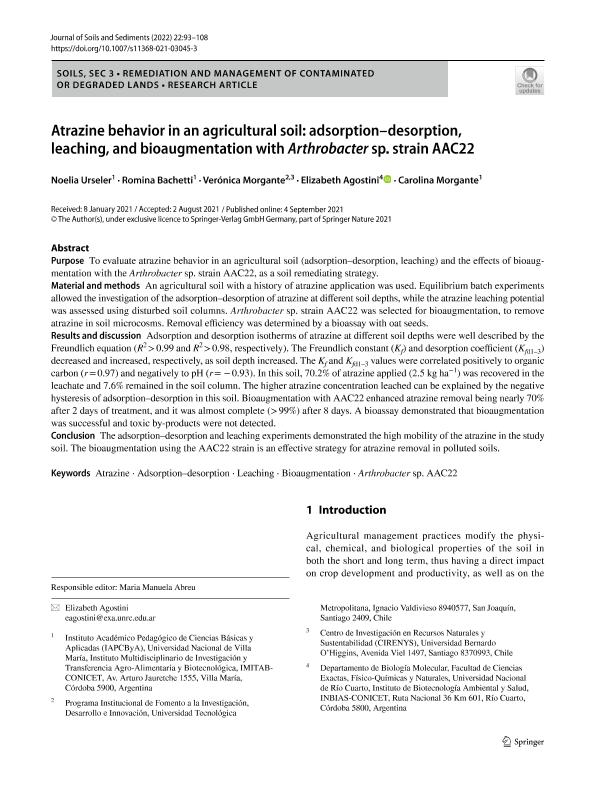Mostrar el registro sencillo del ítem
dc.contributor.author
Urseler, Noelia Luján

dc.contributor.author
Bachetti, Romina

dc.contributor.author
Morgante, Verónica
dc.contributor.author
Agostini, Elizabeth

dc.contributor.author
Morgante, Carolina

dc.date.available
2022-01-14T14:25:44Z
dc.date.issued
2022-01
dc.identifier.citation
Urseler, Noelia Luján; Bachetti, Romina; Morgante, Verónica; Agostini, Elizabeth; Morgante, Carolina; Atrazine behavior in an agricultural soil: adsorption–desorption, leaching, and bioaugmentation with Arthrobacter sp. strain AAC22; Springer Heidelberg; Journal of Soils and Sediments; 22; 1-2022; 93-108
dc.identifier.issn
1439-0108
dc.identifier.uri
http://hdl.handle.net/11336/150105
dc.description.abstract
Purpose: To evaluate atrazine behavior in an agricultural soil (adsorption–desorption, leaching) and the effects of bioaugmentation with the Arthrobacter sp. strain AAC22, as a soil remediating strategy. Material and methods: An agricultural soil with a history of atrazine application was used. Equilibrium batch experiments allowed the investigation of the adsorption–desorption of atrazine at different soil depths, while the atrazine leaching potential was assessed using disturbed soil columns. Arthrobacter sp. strain AAC22 was selected for bioaugmentation, to remove atrazine in soil microcosms. Removal efficiency was determined by a bioassay with oat seeds. Results and discussion: Adsorption and desorption isotherms of atrazine at different soil depths were well described by the Freundlich equation (R2 > 0.99 and R2 > 0.98, respectively). The Freundlich constant (Kf) and desorption coefficient (Kfd1–3) decreased and increased, respectively, as soil depth increased. The Kf and Kfd1–3 values were correlated positively to organic carbon (r = 0.97) and negatively to pH (r = − 0.93). In this soil, 70.2% of atrazine applied (2.5 kg ha−1) was recovered in the leachate and 7.6% remained in the soil column. The higher atrazine concentration leached can be explained by the negative hysteresis of adsorption–desorption in this soil. Bioaugmentation with AAC22 enhanced atrazine removal being nearly 70% after 2 days of treatment, and it was almost complete (> 99%) after 8 days. A bioassay demonstrated that bioaugmentation was successful and toxic by-products were not detected. Conclusion: The adsorption–desorption and leaching experiments demonstrated the high mobility of the atrazine in the study soil. The bioaugmentation using the AAC22 strain is an effective strategy for atrazine removal in polluted soils.
dc.format
application/pdf
dc.language.iso
eng
dc.publisher
Springer Heidelberg

dc.rights
info:eu-repo/semantics/openAccess
dc.rights.uri
https://creativecommons.org/licenses/by-nc-nd/2.5/ar/
dc.subject
ADSORPTION–DESORPTION
dc.subject
ARTHROBACTER SP. AAC22
dc.subject
ATRAZINE
dc.subject
BIOAUGMENTATION
dc.subject
LEACHING
dc.subject.classification
Ingeniería Medioambiental y Geológica, Geotécnicas

dc.subject.classification
Ingeniería del Medio Ambiente

dc.subject.classification
INGENIERÍAS Y TECNOLOGÍAS

dc.title
Atrazine behavior in an agricultural soil: adsorption–desorption, leaching, and bioaugmentation with Arthrobacter sp. strain AAC22
dc.type
info:eu-repo/semantics/article
dc.type
info:ar-repo/semantics/artículo
dc.type
info:eu-repo/semantics/publishedVersion
dc.date.updated
2021-11-09T18:55:20Z
dc.identifier.eissn
1614-7480
dc.journal.volume
22
dc.journal.pagination
93-108
dc.journal.pais
Alemania

dc.journal.ciudad
Heidelberg
dc.description.fil
Fil: Urseler, Noelia Luján. Consejo Nacional de Investigaciones Cientificas y Tecnicas. Centro Cientifico Tecnologico Conicet - Cordoba. Instituto Multidisciplinario de Investigacion y Transferencia Agroalimentaria y Biotecnologica. - Universidad Nacional de Villa Maria. Instituto Multidisciplinario de Investigacion y Transferencia Agroalimentaria y Biotecnologica.; Argentina
dc.description.fil
Fil: Bachetti, Romina. Consejo Nacional de Investigaciones Cientificas y Tecnicas. Centro Cientifico Tecnologico Conicet - Cordoba. Instituto Multidisciplinario de Investigacion y Transferencia Agroalimentaria y Biotecnologica. - Universidad Nacional de Villa Maria. Instituto Multidisciplinario de Investigacion y Transferencia Agroalimentaria y Biotecnologica.; Argentina
dc.description.fil
Fil: Morgante, Verónica. Universidad Tecnologica Metropolitana (utem); . Universidad Bernardo O’Higgins; Chile
dc.description.fil
Fil: Agostini, Elizabeth. Universidad Nacional de Rio Cuarto. Facultad de Cs.exactas Fisicoquimicas y Naturales. Instituto de Biotecnologia Ambiental y Salud. - Consejo Nacional de Investigaciones Cientificas y Tecnicas. Centro Cientifico Tecnologico Conicet - Cordoba. Instituto de Biotecnologia Ambiental y Salud.; Argentina
dc.description.fil
Fil: Morgante, Carolina. Consejo Nacional de Investigaciones Cientificas y Tecnicas. Centro Cientifico Tecnologico Conicet - Cordoba. Instituto Multidisciplinario de Investigacion y Transferencia Agroalimentaria y Biotecnologica. - Universidad Nacional de Villa Maria. Instituto Multidisciplinario de Investigacion y Transferencia Agroalimentaria y Biotecnologica.; Argentina
dc.journal.title
Journal of Soils and Sediments

dc.relation.alternativeid
info:eu-repo/semantics/altIdentifier/url/https://link.springer.com/article/10.1007%2Fs11368-021-03045-3
dc.relation.alternativeid
info:eu-repo/semantics/altIdentifier/doi/http://dx.doi.org/10.1007/s11368-021-03045-3
Archivos asociados
